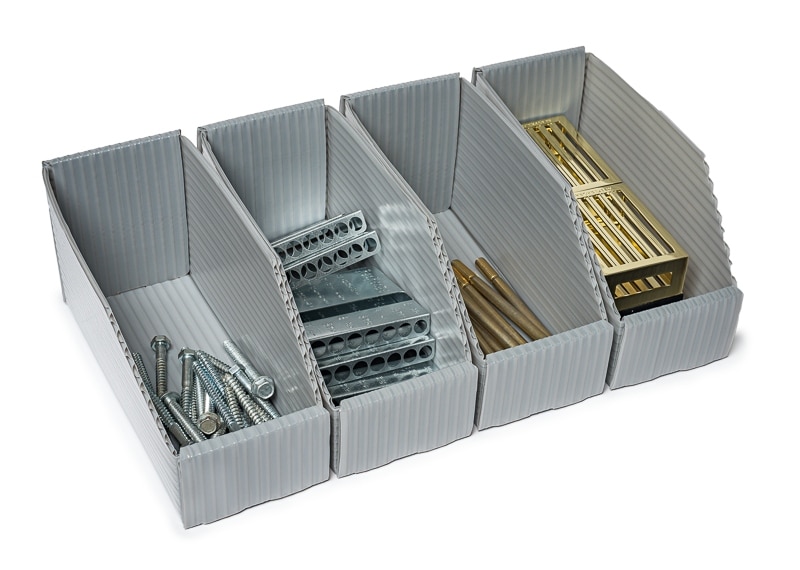Spare parts inventory is a stock of components kept on hand to repair or replace failed or broken elements in a production system, equipment, or machine. Spare parts management involves controlling and organizing spare parts’ storage, supply, and distribution.
Spare parts inventory management ensures the availability of components when needed while minimizing inventory holding costs. The objective is to balance the need for having enough spare parts available for immediate use with the cost of storing and maintaining them.
Best Practices in Spare Parts Inventory Management
Several methods and techniques effectively optimize the storage and supply of spare parts. Let’s look at some essential spare parts inventory management best practices.
Classification and Categorization of Spare Parts
Classification and categorizing a spare parts inventory system helps organize and manage inventory efficiently, reduce costs, and improve equipment availability. Here is a way to classify and categorize your parts stock.
Criticality Analysis
Criticality analysis aims to identify which parts are essential for the smooth functioning of a system and which parts are less important.
Elements with high criticality ratings are considered more critical and prioritized in inventory management. These parts get maintained in higher quantities, and quick and reliable access to them is crucial to minimize downtime and improve equipment availability.

Color-Coded Bins
Storage bins for spare parts can also be color-coded to give visual cues for different product categories, if applicable. Doing so will ease the re-stocking and order picking process for employees as, over time, they will gain familiarity with what product or part is associated with what color. For example, depending on the products or parts available at your company, colors can be used as follows:
- Blue: Medical device parts
- Green: Product labels
- Yellow: Shrink wrap packaging
- Red: Gift packs
Stock Optimization Techniques
Stock optimization techniques balance the need for enough spare parts with the cost of storing and maintaining them.
Safety Stock Calculation
One of the techniques is safety stock calculation, used to determine the optimal level of safety stock to be maintained. Safety stock is an additional stock kept on hand to ensure that critical parts are available in case of unexpected demand or supply chain disruptions.
ABC Analysis
Another technique is ABC analysis which prioritizes the management of different parts based on their relative importance. The technique classifies elements into three categories based on annual consumption value or usage frequency. The items of priority get stocked at higher numbers than the rest.
Stock Replenishment Techniques
Stock replenishment techniques are methods used to determine when and how much of a spare part to order or produce. These techniques ensure that spare parts are available at the right time and place without incurring the cost of holding excess inventory. They include reordering point calculation, just-in-time, and the kanban system.
Reorder Point Calculation
Reorder point calculation determines the optimal order quantity for a spare part. It is calculated based on average daily consumption for a spare part, lead time to receive the next shipment, and desired safety stock. An order gets placed when inventory drops below a reorder point.
The minimum order quantity calculation determines the minimum amount of a spare part ordered or produced to minimize the inventory cost. In the vendor-managed technique, the vendor is responsible for managing parts inventory, ensuring they are available promptly.
Just-In-Time (JIT) Inventory Management
Just-in-time is also a stock replenishment technique used in spare parts inventory management systems. It is a lean manufacturing philosophy where spare parts get delivered to the customer just in time for use rather than being kept in inventory. In a JIT system, waste on production and returns gets reduced as the product production is to customer specifications.
Kanban System
Kanban inventory control is another stock replenishment technique based on cards and bins. It aims to order spare parts only when needed, reduce inventory costs, and improve equipment availability. The system also eliminates waste of overproduction and reduces lead time, increasing customer satisfaction.
Inventory Visibility and Control
Inventory visibility and control refer to an organization’s ability to track, monitor, and manage its spare parts inventory system at all times. Let’s look at some ways companies can use it to maintain visibility.
Inventory Management Software
Inventory management software tracks, manages, and organizes a company’s surplus parts inventory. It provides organizations with real-time information about their inventory, allowing them to effectively make informed decisions about managing parts inventory. The parts inventory system also monitors stock movements and automates the reordering process.
Real-Time Inventory Tracking
Real-time inventory tracking refers to the ability of inventory management software to provide up-to-date information about inventory levels, locations, and conditions. It allows organizations to have real-time visibility into their inventory and make informed decisions about inventory management.

Cost Control
There are several strategies to consider while managing parts inventory in cost control. Here are some of the strategies.
Minimizing Obsolescence
Obsolescence refers to spare parts becoming outdated or no longer needed, leading to surplus inventory and wasted resources. Organizations must regularly check their spare parts stock to minimize obsolescence and assess the demand for each part.
Reducing Surplus Inventory
Companies must also reduce surplus inventory for spare parts management. Surplus inventory refers to spare parts not in use in the immediate future. Organizations can mitigate excess inventory by considering usage patterns, JIT production, and lean philosophies.
Proper Pricing Strategies
Proper pricing strategies are crucial for effective management of a parts inventory system. Pricing affects demand and the inventory level required to meet that demand. Companies must consider the cost of acquiring and holding the spare parts and the market for each to establish a proper pricing strategy.
Supplier Management
Supplier management involves overseeing the relationships and interactions with spare parts suppliers. It includes sourcing and selecting suppliers, negotiating contracts, and monitoring supplier performance.
Selection of Suppliers
The selection of suppliers lays the foundation for a successful supplier relationship. Good supplier selection ensures a reliable and consistent supply of high-quality parts that meet the organization’s needs. Organizations must thoroughly evaluate potential suppliers based on delivery performance and reliability to ensure prompt delivery.
Negotiating Contracts and Terms
Negotiating contracts and terms with suppliers is also a critical aspect of supplier management. This process involves establishing a mutually beneficial agreement between the organization and its suppliers that outlines each party’s expectations. Negotiating terms may include delivery reliability and methods to avoid supplier inconveniences.
Supplier Performance Monitoring
Supplier performance monitoring aims to ensure that suppliers meet their obligations as outlined in the contracts and identify potential issues or areas for improvement. Performance monitoring can also involve tracking supplier metrics such as delivery performance, product quality, and responsiveness to requests.
Challenges in Spare Parts Inventory Management
Here are some challenges facing spare parts management.
Forecasting Demand
Forecasting demand for spare parts is challenging as it predicts future customer demand for replacement parts. Spare parts demand is also highly sporadic and can be daunting to forecast, making it hard to maintain adequate inventory levels and avoid stockouts or overstocking.
Maintaining the Accuracy of Inventory Data
Keeping accurate inventory data is essential for effective inventory control and decision-making. It helps organizations track spare parts’ availability, determining and preventing stock outs or overstocking. However, human error, system malfunctions, and physical damage to inventory affect the accuracy of inventory data.
Balancing Inventory Levels With Service Level Requirements
Balancing inventory levels with service requirements is a significant challenge in managing spare parts inventory. It involves finding the optimal balance between having enough stock to avoid stockouts and avoiding excessive inventory levels leading to waste and increased costs.
Finding the right balance requires a deep understanding of demand patterns, customer needs, and the cost structure of the spare parts inventory.
Efficient Spare Part Inventory Management: Key Practices to Optimize Your Operations
Spare parts management is critical to any maintenance or repair operation. Effective spare parts management requires balancing inventory holding costs and stock-out costs.
By following these parts inventory management best practices, organizations can minimize costs and ensure that critical spare parts are readily available when needed. They must also continuously improve and adapt to changing circumstances to align with their operations’ current needs.
Contact MDI today to learn more about spare part inventory management.